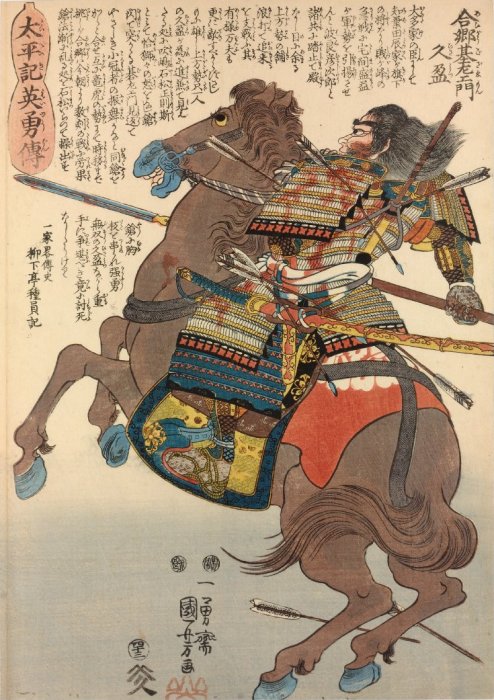Bajutsu on:
[Wikipedia]
[Google]
[Amazon]
 is a Japanese form of military
is a Japanese form of military
 is a Japanese form of military
is a Japanese form of military equestrianism
Equestrianism (from Latin , , , 'horseman', 'horse'), commonly known as horse riding (Commonwealth English) or horseback riding (American English), includes the disciplines of riding, Driving (horse), driving, and Equestrian vaulting, vaulting ...
.
History
Although its origins are closely related to those of mounted archery (''yabusame
is a type of mounted archery in traditional Japanese archery. An archer on a running horse shoots three special "turnip-headed" arrows successively at three wooden targets.
This style of archery has its origins at the beginning of the Kama ...
''), bajutsu is considered a distinct and separate martial art, and there are a number of traditional schools, such as the Ogasawara, Otsubo, and Hachijo. The art originated in the 7th century AD during the reign of Emperor Tenji
, also known as Emperor Tenchi, was the 38th emperor of Japan, Imperial Household Agency (''Kunaichō'')天智天皇 (38)/ref> according to the traditional order of succession.Ponsonby-Fane, Richard. (1959). ''The Imperial House of Japan'', p. 5 ...
but was popularised in the 12th century as large-scale mounted warfare became more common. However, the comparative scarcity of horses in Japan meant that bajutsu was always an elite art, restricted to high-ranking samurai
were the hereditary military nobility and officer caste of medieval and early-modern Japan from the late 12th century until their abolition in 1876. They were the well-paid retainers of the '' daimyo'' (the great feudal landholders). They h ...
.Lowry, d; ''The Karate Way: Discovering the Spirit of Practice'' Shambhala Publications, 2009 p55 In spite of this, many contemporary historians ignored the numbers of foot-soldiers in battles and referred to the size of armies by the number of horsemen alone. Friday, Karl; ''Samurai, warfare and the state in early medieval Japan'' Psychology Press, 2004 p96-101
The comparative peace of the Tokugawa era
The or is the period between 1603 and 1867 in the history of Japan, when Japan was under the rule of the Tokugawa shogunate and the country's 300 regional ''daimyo''. Emerging from the chaos of the Sengoku period, the Edo period was characterize ...
from 1600 onwards led to a decline in the military practice of bajutsu, and it became relegated to a more ceremonial role, indeed, the practice of horsemanship was actively discouraged during the reign of Tokugawa Tsunayoshi
was the fifth ''shōgun'' of the Tokugawa dynasty of Japan. He was the younger brother of Tokugawa Ietsuna, as well as the son of Tokugawa Iemitsu, the grandson of Tokugawa Hidetada, and the great-grandson of Tokugawa Ieyasu.Nussbaum, Louis-Fr ...
. By the beginning of the 20th century there were more than 20 schools of bajutsu and the Japan Bajutsu Federation was formed in Tokyo in 1946 to promote it as a modern sport.
Techniques
As well as requiring proficiency in riding and mounted sword-fighting, the art also included teachings on the care and upkeep of horses. Horses were trained to ignore sudden shocks, and to press forward in the charge, veering off at the last second to allow the rider to kick with his battering-ram-likestirrups
A stirrup is a light frame or ring that holds the foot of a rider, attached to the saddle by a strap, often called a ''stirrup leather''. Stirrups are usually paired and are used to aid in mounting and as a support while using a riding animal (u ...
. These stirrups (''shitanaga abumi'') were designed to enable the rider to stand and shoot easily from the saddle
The saddle is a supportive structure for a rider of an animal, fastened to an animal's back by a girth. The most common type is equestrian. However, specialized saddles have been created for oxen, camels and other animals. It is not kno ...
. Cavalry charges were made possible by the development of spear
A spear is a pole weapon consisting of a shaft, usually of wood, with a pointed head. The head may be simply the sharpened end of the shaft itself, as is the case with fire hardened spears, or it may be made of a more durable material fasten ...
techniques from horseback in the late 14th century, supplanting the mounted archery styles that had previously dominated.Turnbull, Stephen; ''War in Japan 1467-1615''Osprey Publishing, 2002 p16 Such charges were used to great effect by the Takeda clan
The was a Japanese samurai clan active from the late Heian period until the late 16th century. The clan was historically based in Kai Province in present-day Yamanashi Prefecture. The clan reached its greatest influence under the rule of Taked ...
, who introduced the tactic during the mid- to late- sixteenth century, but after the Battle of Nagashino
The took place in 1575 near Nagashino Castle on the plain of Shitaragahara in the Mikawa Province of Japan. Takeda Katsuyori attacked the castle when Okudaira Sadamasa rejoined the Tokugawa, and when his original plot with Oga Yashiro for taki ...
, were used only in conjunction with infantry manouevres.
References
See also
*Yabusame
is a type of mounted archery in traditional Japanese archery. An archer on a running horse shoots three special "turnip-headed" arrows successively at three wooden targets.
This style of archery has its origins at the beginning of the Kama ...
* Horse racing in Japan
; Horse racing in Japan is a popular equestrian sport, with more than 21,000 horse races held each year. There are three types of racing that take place in Japan - flat racing, jump racing, and Ban'ei Racing (also called Draft Racing).
In Japa ...
{{Commons category, Depictions of samurai on horses
Japanese martial arts
Equestrian sports